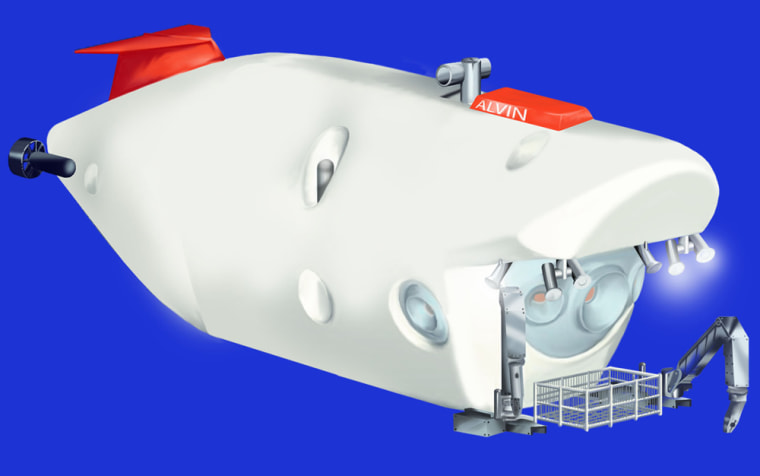A new deep-sea research vessel will be able to carry people to 99 percent of the ocean floor, diving deeper than the famed Alvin that pioneered the study of seafloor vents, plate tectonics and deep-ocean creatures over the past 40 years.
The new American submersible will provide the tools to reach “not for the stars but for the depths,” Robert Gagosian, president of the Woods Hole Oceanographic Institution, said Friday at a briefing at the National Science Foundation.
France, Russia and Japan also operate deep-sea research vessels, and China is building one, officials said. The new ship will have similar capabilities.
It will dive thousands of feet deeper than Alvin, carry more scientific instruments, communicate more quickly and stay down longer.
Alvin “has been a trusted trouper for four decades and a good friend, but science advances, and so does technology,” said Arden Bement, acting director of NSF.
Launch expected in 2008
Design for the Alvin Replacement Vessel is under way, with launch expected in 2008, officials said.
The vessel is expected to be able to descend more than 21,000 feet (6,500 meters) into the ocean. Alvin dives to just short of 15,000 feet (4,500 meters). The new capability will still remain short of the deepest spot in the oceans, more than 36,000 feet (11,000 meters) in the Mariana Trench.
Only the bathyscaph Trieste — in 1960 — has carried people to that depth, taking just two people there, a fraction of the 12 who have walked on the moon.
The new vessel is expected to cost $21.6 million, paid for by the NSF, with additional funding from Woods Hole for instruments, lighting and sensors. It will operate from the Research Vessel Atlantis, the same ship that now tends Alvin. Operating costs are expected to be similar to the current approximately $22,000 a day for the Atlantis, plus $10,000 a day for the research vessel.
The NSF will own the new vessel, but it will be operated by Woods Hole, which currently coordinates use of the Navy-owned Alvin. Once the new vessel is in use, the Navy will decide Alvin’s future.
Deeper divers planned
Dan Fornari of Woods Hole said there also are plans for a remotely operated vessel to explore the ocean’s deepest trenches to study the methane hydrate there as a possible energy source, the exchange of fluids between the sea and Earth’s mantle and the creatures that live in those lightless depths.
Officials said the new vessel’s name has not been selected, although an artist-drawing of the planned design carried the name Alvin.
The name Alvin was bestowed whimsically by scientists amused by a popular song featuring a singing chipmunk. Some have suggested the new vessel be named for one of that chipmunk’s companions, Simon or Theodore.
Launched in 1964, Alvin has conducted 4,025 dives and spent more than 27,000 hours submerged, including 16,000 on the ocean bottom. It has carried 12,068 people beneath the waves on missions to study biology, geology, chemistry, search and recovery and other topics.
Highlights of Alvin's history
Just two years after it was launched, Alvin was sent to the coast of Spain to help recover a hydrogen bomb lost in the sea off the coast of Spain after a midair collision of a U.S. bomber and a tanker aircraft.
On July 6, 1967 the vessel was attacked by a swordfish, which became entangled in the submersible’s equipment. The fish came to the surface with Alvin and became dinner for the crew.
During launch for a dive in October 1968, Alvin’s support cables failed and the vessel sank in 5,000 feet (1,500 meters) of water. The pilot escaped but the vessel remained on the bottom until the following year. Lunches left on board were found to be soggy but edible, thanks to near-freezing temperatures and lack of oxygen at the bottom.
Alvin has led to some significant scientific breakthroughs. During a 1977 Pacific Ocean study, scientists aboard Alvin discovered animal life forms that forced them to change theories about the generation of life. Since the animals were in water so deep no light penetrates, they had to live without photosynthesis, depending on chemicals released from warm water vents.
Two years later, researchers aboard Alvin found similar life forms as it studied the black smoker vents in the seafloor on the East Pacific Rise.
By its 30th anniversary in 1994, officials noted, none of the original submersible remained, every part having been replaced at some point.
